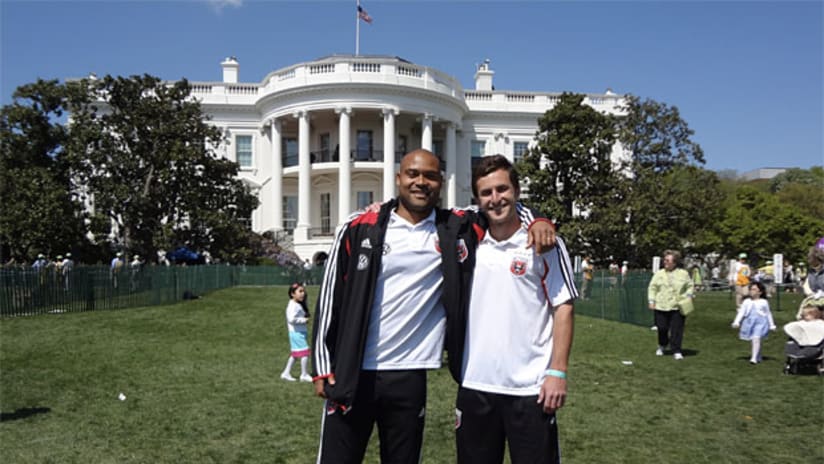Every Easter season for the last 134 years, the President of the United States and his family have welcomed first hundreds, then thousands of children and their families to the nation’s capital for the White House Easter Egg Roll.
This time-honored tradition gives young Americans a chance to play on the lush green lawn that is usually off-limits to all but the President and his inner circle, and lately has grown to include a wide range of activities designed to promote presidential programs in health and wellness, exercise, literacy and the like.
“It’s a great country when you can smash a hard-boiled egg down a hill with a spoon in front of the leader of the free world’s house,” said Edward Felsenthal of New York City, who was attending the event with his wife Allie and their young daughters Sophie (3 years old) and Louise (18 months old).
Chefs, athletes, musicians, poets, and many other notables have been invited to take part, and the 2012 edition on Monday was no different, when an illustrious list of guests joined President Barack Obama, his wife Michelle and their daughters Sasha and Malia for the all-day celebration at the White House.
I was fortunate enough to cover the Egg Roll for MLSsoccer.com, thanks to a modest, but undoubtedly reassuring, sign of soccer’s increasingly secure place in the American consciousness: several Major League Soccer and U.S. Women’s National Team players and one coach, D.C. United’s Ben Olsen, were involved. They were tasked with guiding children of many ages through a dribbling exercise as part of the event’s “Eggtivity Zone,” based on the First Lady’s “Let's Go, Let's Play, Let's Move” initiative.
“Working alongside other professional athletes – we were near NFL players – I think it speaks to the level [MLS] has grown to,” Philadelphia Union midfielder and Springfield, Va. native Brian Carroll told The Soccer Wire afterwards.
“Certainly we’re not satisfied with where we’ve gotten to and we want to continue to grow the sport…[but] the idea of growing up and living through sports, the amount of enjoyment that sports and play can bring to child development around the country, it’s a tremendous honor to be a part of.”
Carroll was one of eight MLS players representing three clubs, with standouts from D.C. United and the New York Red Bulls also present. Most admitted that they were pleasantly surprised by how widely recognized they were, with all being repeatedly approached for autographs and photo opportunities by children and adults alike.
“Even since I’ve been in the league [2008], people come up to us now and they know about MLS, they know about the team and ask questions specifically about certain players and certain things,” said United’s Stephen King. “Just seeing the game grow, we definitely notice it, especially at events like today.”
High-profile setbacks like the U.S. Under-23 Men’s National Team’s recent failure to qualify for the Olympics still set off waves of concern, even alarm about soccer’s progress in this country, and Men’s National Team head coach Jurgen Klinsmann’s ongoing reevaluation of the federation’s development structure shows that many in and around that program see chronic underachievement. Even still, we can clearly see rising awareness and expectations in those instances, and the public debates they provoke.
But perhaps the biggest mountain still to climb is the fostering of what one MLS GM once described to me as “the 24/7 soccer culture,” that is, a general passion for the game across a substantial spectrum of American life. This state of immersion and emotional investment is a given in many parts of the world – and in some places it is so intense as to actually create fear and stress for coaches and players – but it remains difficult to find here, at least outside certain geographical or ethnic pockets.
That’s why I take heart from milestones like the White House Easter Egg Roll, where our government’s executive branch has now made the inclusion of pro soccer players a normal occurrence, and kids wearing soccer warm-up jackets and Lionel Messi FC Barcelona jersies were nearly as common as those in football and baseball garb.
“It just goes to show that the league and soccer is growing in this country,” said Philadelphia defender Danny Califf. “It’s getting more prominent and is getting more and more respect every single year. To be involved in this – not just a team winning a championship that goes for a photo-op, but being a part of this with other sports teams – is pretty incredible.”




